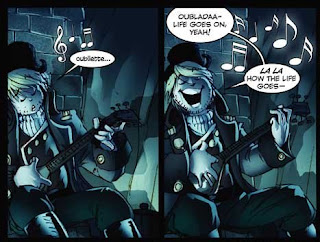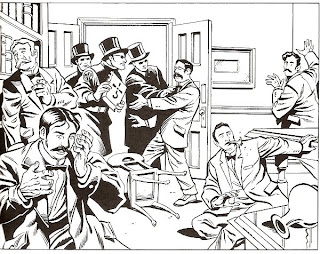

Digging through the vault archives, I sometimes come across a book I don't remember. Not in a "I forgot I had this" way, but more in a "What the hell is this?" way. I literally remember nothing about the title in question.
And that's to be expected when you've accumulated several thousand issues across forty years or so. Some things you buy once, you read, you say, "meh," then you bag it up and toss it in a box and never give it another thought. Then years later, you run across a random single issue of whatever and say, "What the hell is this?"
The thing that freaked me out when I ran across
Eagle was, I had bought the first 10 issues. So I must have liked it, at least enough to keep buying it month after month. And yet, I had absolutely no memory of this book whatsoever. Why? Rereading the series, I figured out the answers.
I apparently kept buying the series because I wanted like hell to love this book.
Eagle was an independent title published by Crystal Comics during the big black-and-white boom of the 80's (1986, to be precise). It was drawn by Neil Vokes and Rich Rankin (who apparently also co-plotted), with scripts by Jack Herman. Now, none of those guys have gone on to become huge household names, but they had all been connected to projects that were dear to my heart at the time.
Vokes had been penciling one of Comico's Robotech books, adapting the animated series; I liked the TV series, but was only lukewarm on the comics. Rankin, meanwhile, had started out inking Bill Willingham's
Elementals, which I loved. I have a Rankin-inked
Elementals page hanging on my wall at this moment, in fact.
But see, the thing about
Elementals was, it had its beginnings in a game module for a superhero role-playing game called
Villains and Vigilantes, which I played. And
Villains and Vigilantes was designed by a couple of guys named Jeff Dee and Jack Herman.
So here was
Eagle, penciled by a guy who also adapted anime, inked by a guy who also inked one of my favorite books at the time, and scripted by a guy who co-designed a game I liked. In addition, Matt Wagner (creator of
Mage and
Grendel) did the colors for the first issue's cover and contributed a pin-up, Arnold Pander (of the Pander Brothers, who did a long run as artists on
Grendel) helped design the logo, and various other up-and-coming names (like Marc Hempel and Adam Hughes) continued to contribute to the book.
It was like these guys were all buddies just hanging out together and putting out this little labor o' love comic on the side, and I wanted to feel like I was part of that circle, so I kept buying the book, hoping that these talents whose other work I liked would eventually turn it into something awesome.
Unfortunately, the awesome never happened with
Eagle. It was, literally, forgettable.
Eagle stars Richard Eagle (though we don't learn his first name for several issues), a master martial artist who works as a sort of private detective-slash-bodyguard (I wrote out the slash, because he literally slashes people--notice the sword on the cover above). He is also a powerful magician, drawing power from a mysterious orb that resides within his chest. The orb itself is a malign entity that slowly takes him over whenever he uses its power, so he uses it only reluctantly.

He also has a less-than-friendly relationship with the police. And in this scene from the first issue (click the pic for a larger version), we see one of the problems with the book. There is some extreme storytelling compression going on in this scene, what with the cop being over-the-top belligerent, and then cowering like a puppy after one good hard stare from Eagle. Only the art doesn't really carry off the extreme bad-assedness we're supposed to get here, there's no caption telling us what a powerful presence Eagle is, and the dialogue is stiff and somewhat nonsensical (what exactly would they charge him on--aggravated staring?). The whole scene feels cliched and underdeveloped.
Also, the ugly cop there? The reason he's so ugly is that he's an alien (although we don't find that out until issue #8, so until then, I just assumed he was badly drawn). And that becomes another of the problems with the book. This is, in many ways, a book by fans for fans, so there's a sort of throw-everything-in-there-and-see-what-sticks sense to the story. Eagle is a martial artist, but this isn't a martial arts story. Eagle is also a magician, but magic isn't really central to the story, either. Aliens and time travelers wander in and out of the book, but none of them really give the book any sort of firm direction. There were elements in there, like Eagle's relationship with the orb, that promised drama in the future, but it never came together and ended up seeming kind of aimless.

The art, meanwhile, had its ups and downs.
Here's an example of the art at its best. This is a scene from issue #7, where Eagle is fighting a Dr. Strange-inspired astral battle with the spirit of the orb. Dramatic layout, good solid drawing, simple and powerful inks with a nice balance between lights and darks and just the right touch of zip. Gorgeous.
All to often, though, we got scenes like the one above, a little stiff and clumsy, both the pencils and the inks feeling off-balance.
Another example is below, a romantic scene between Eagle and his love interest, city councilwoman Sivia Myers. Her large eyes say young, but her sunken cheeks make her look old. And in black-and-white it's hard to tell if her hair is white or blonde. So, is she young or middle-aged or even old? Hard to tell, and we should be able to, especially given what a major character she is.

 Eagle
Eagle did manage to create one relatively successful breakout character, a Terminator-inspired defender from the future named Death's Head, first seen in issue #4 (followed in issue #5 by a completely different Terminator-inspired character who fights a street gang inspired by Mike Baron's
Badger--like I said, this was a book by fans for fans). He returned in issue #7 and had his own spin-off published for one issue before running afoul of Marvel's legal team (turns out they had trademarked a minor character named Death's Head themselves).
Death's Head was cool. Strong, silent, nicely designed. The one thing that annoyed me about him, though, was that his guns were never explained. Most of the time, he walked around empty-handed as in the panels at right. Every now and then, though, he'd shoot these double-barreled shotgun pistols, but he wore no holsters, so you never saw where they came from. They were just in his hands in the panels where he needed them, and then gone the next. But it's never mentioned that they magically appear or disappear. For all I know, he pulled them out of his ass.
Eagle eventually ran 23 issues, followed up several years later by a 4-issue miniseries. Vokes has rereleased
Eagle in e-book form and is apparently planning on doing more Eagle someday. You can learn more
here.







































